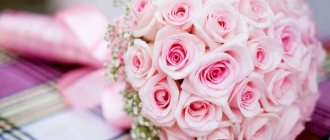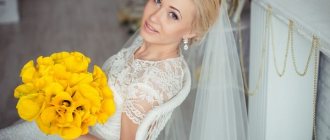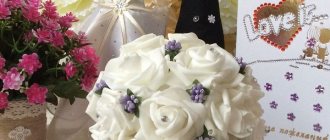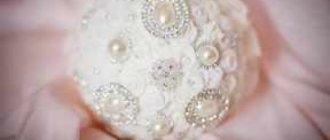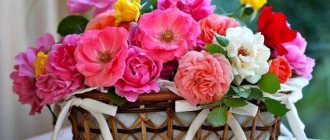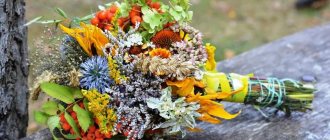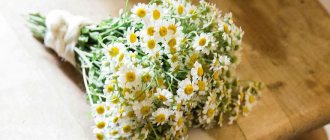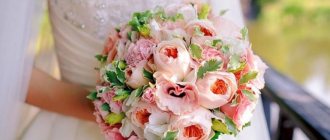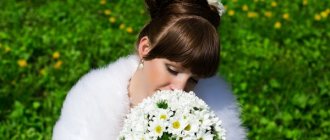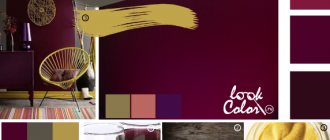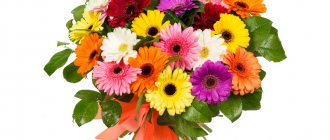Flowers in the hands of the bride are a mandatory attribute of any wedding. A symbol of tenderness, purity, youth, femininity, it is designed to complement the girl’s image and should be combined with her outfit and appearance.
The groom is obliged to give a bouquet to the bride on the wedding day; the girl accepts it as a sign of consent to get married.
Photo of a bride's wedding bouquet made of hydrangea
Meaning of colors
The language of flowers has long been used to express feelings. On it, hydrangea (another name for this flower is hydrangia) means modesty, truthfulness, faith and hope .
Necessary qualities for a girl entering family life, swearing an oath of fidelity to her lover. Hydrangia given to someone also signifies a declaration of love.
By choosing a wedding bouquet with these flowers, the bride promises her future husband to be a faithful wife, a tender, devoted life partner. Important! It is believed that this lovely flower will bring a calm atmosphere to the home, peace, goodwill, the newlyweds will be healthy, and their family life will be prosperous.
In addition, hydrangea flowers are very impressive and go perfectly with a lush wedding dress. This flower personifies the brilliant beauty of the bride, her uniqueness, her difference from other women on her most special day.
Flower symbolism
- The birthplace of the flower is Japan, so the flower is still sometimes called the “Japanese rose” for its beauty. The Japanese believe that it protects a young family from evil and misfortune , so the flower is often used to create festive flower arrangements.
- In European countries, it symbolizes health, friendliness and family well-being .
- According to another meaning, the flower symbolizes frugality, fidelity, devotion , and a bouquet of hydrangeas placed at home will smooth out conflicts and preserve the spiritual comfort of its inhabitants.
How to match a girl's style?
When choosing hydrangea to decorate the bride’s wedding bouquet, you need to consider some points:
- A wedding bouquet, like a dress, should reflect the personality of the bride. The best image is one in which the appearance matches the inner content. A classic composition of hydrangeas will especially elegantly emphasize the beauty of gentle romantic girls;
- A spectacular ball of hydrangia should not be made too large for miniature people , so as not to upset the proportions;
- Tall, slender brides in classic long dresses will benefit from cascading floral arrangements;
- Bright, daring people should add other flowers to hydrangeas , for example, exotic lilies or orchids;
- If the bride wants to emphasize her originality, an asymmetrical bouquet with hydrangeas , which has “disheveled” shaggy outlines, will suit her.
The bouquet should act as a single whole with the overall wedding scenario. Fortunately, hydrangia has many faces. It will decorate a classic lavish celebration, a wedding in a rustic style, or an elegant retro ceremony.
Legends about girls named Hortensia
The Legend of Madame Lepot
According to one legend, this beautiful plant is named after the outstanding Frenchwoman - Nicole-Reine Etable de la Brière (after her husband, Madame Lepaute, Nicole-Reine Lepaute).
Nicole-Reine Etable de la Brière was born in Paris on January 5, 1723. While still very young, she made a trip around the world, full of dangers. At the age of 25, she became the wife of the court watchmaker Lepota and, under his name, became famous as the first female mathematician and astronomer in France. She participated in the calculation of the orbit of Halley's comet, calculated and compiled a detailed map of the annular solar eclipse observed in Paris in 1764. Her merits as a scientist were recognized, her works were published in publications of the Paris Academy.
So, according to one of the legends, it was in honor of Madame Lepaute that Philibert Commerson named the flower “potia,” but then another naturalist, A. Jussier, changed it to what is already familiar to us - “hydrangea.” This is how the legend of Hortense Lepot arose.
The Legend of Jeanne Barre
According to another version, Hortense appears as Commerson’s own lover, who traveled with him, dressed in a man’s dress. Her name was Jeanne Barret.
In 1765, Bougainville invited Commerson to take part in the expedition. Dressed in a man's dress, like a servant Jean, his housekeeper and, possibly, lover went with him. There was a strict ban on female representatives on the ship, so Zhanna hid for quite a long time. She helped Commerson collect plant samples, as she was well versed in them. But exposure came, and Bougainville decided to leave both on the island of Mauritius, where Commerson died in 1773. Jeanne returned to France and got married. For services to the fatherland she was awarded a pension.
In honor of Jeanne, Commerson named two more plants: Baretia bonafidia and Solanum baretiae, in which her name is already easily read. But if you believe one popular American writer, then when she returned to France, she changed her name to Hortense. Perhaps she simply reverted to her real name, and the second, Jeanne, was actually a feminine version of her father's name, Jean. Another mystery for historians. By the way, it is absolutely known that the mountains (Baret Montes) on Pluto were named in her honor on April 26, 2022.
The Legend of Princess Hortense
There is also a theory that hydrangea was named after Princess Hortense, the sister of Prince Karl Heinrich Nikolaus Otto von Nassau-Siegen. Commerson named this beautiful flower so to please the prince. However, the prince was an only child. However, it is possible that the lady in the portrait had a more distant family or not entirely family relationship with the prince.
Composition ideas
Brides and wedding florists adore hydrangea for its rich color hues. In addition to classic white, you can choose soft blue, light green, pale pink or lilac.
Lovers of rich, bright colors should pay attention to the rich colors of lush inflorescences - yellow, blue, purple, crimson, lilac. There are few competitors to whom hydrangea is ready to yield in terms of richness and richness of shades.
The most popular color schemes for wedding bouquets with hydrangeas:
- pink shades of flowers for a spring wedding;
- compositions of purple, blue or burgundy tones for an autumn celebration.
Often hydrangia is compositionally combined with other flowers - peonies, roses, orchids, lilies, callas. And here florists have no less room for creativity, for example:
- the “leading” role is assigned to other colors, and hydrangea is used for a spectacular floral background - neutral or contrasting;
- All flowers of the bouquet are selected in a single color scheme, creating a monochromatic composition.
Idea! Mono-bouquets of hydrangea are very popular and are considered a simple, elegant and stylish solution for any look.
Among the flower favorites:
- a combination of white hydrangia with white peonies or roses;
- an alliance of pink hyacinths and matching hydrangeas;
- contrasting “unions” of innocent white and rich purple flowers.
White, blue, dark blue in a mono bouquet
A mono-bouquet is made up of flowers of the same type and color, but a play of shades within the same basic tone is allowed. White, blue and blue hydrangeas are ideal for such compositions:
- Snow-white hydrangia is a light foamy cloud in the hands of the bride. The best addition to a classic romantic look. The personification of the purity and innocence of a young girl entering into marriage;
- Blue hydrangea has a rich color with a milky tint. She looks good with a bolder, edgier look;
- Blue flowers in the bride's bouquet become a bright, noticeable accessory. This original compositional solution suits extraordinary, decisive people.
When composing a mono-bouquet, both larger and smaller flowers are selected.
With roses
The combination of hydrangea and rose is often used to create wedding flower arrangements. Lush rose buds are harmoniously complemented by wavy hydrangia petals, forming a beautiful wedding bouquet.
Popular color combinations:
- cream or peach rose buds against a general background of white hydrangeas;
- all shades of pink roses are elegantly combined with purple, blue, lilac hydrangeas, creating a bold, even daring version of the bride’s bouquet;
- large white roses against a background of milky blue small and large hydrangea flowers help to create a romantic, stylish composition;
- contrast of colors, where in a ball bouquet roses and hydrangeas in rich shades, for example, pink, lilac, form clear color sectors.
Interesting options are when small rose buds serve as a background for large, lush varieties of hydrangea.
With peonies
Peonies look just as good as roses with hydrangeas. Unlike roses, whose buds are clearly defined, the peony flower is softer and more lush. It does not have a rigid outline and gives the composition lightness, playfulness, and charm. At the same time, peonies can be used to create bouquets of any shape, including classic balls with clear outlines.
Important! Most varieties of peonies bloom in June-July, so a bouquet of peonies and hydrangeas is the recognized king of summer weddings.
Frequently used combinations of peonies and hydrangia:
- white peonies on a colored background of blue, pink or pale green hydrangeas;
- bright color accents of richly colored peonies (red, pink, burgundy) on a white or cream background of hydrangeas;
- A very impressive bouquet that combines small closed and lush open peony buds.
With orchids
The orchid is an aristocratic, exquisite flower. In a wedding bouquet with hydrangeas, the orchid takes center stage due to its spectacular shape. For holiday floristry, the orchid is valuable for its richness of flowers. White, cream, yellow, pink orchids harmonize with the wedding dress. For bold adventurous natures, bouquets with accents of red orchids are suitable.
Of the most popular varieties of orchids for a wedding bouquet with hydrangeas, the following are used:
- cone-shaped vanda;
- large and spectacular cymbidium;
- cascading phalaenopsis.
Different shapes of orchid flowers in combination with hydrangea allow you to create compositions of any shape - classic round, cascading, asymmetrical.
With lilies
No less elegant than the combination of orchids and hydrangeas is a composition with lilies. Lily buds are large, with long graceful petals and a noticeable core. This artsy tropical flower goes well with the delicate wavy caps of hydrangeas, creating an extraordinary composition.
To decorate brides' bouquets, they use all colors of lilies: from classic white, pale yellow and cream to two-color buds. Cute and exotic, for example, white lilies with a juicy pink core or burgundy with white edging of petals. “In the foam” of hydrangeas of a similar or contrasting shade, they look great.
Color spectrum
Often, the inflorescence of one plant combines a two-color palette, which allows you to choose the ideal shade of the flower. Many color variations give you wide scope when creating a wedding composition with the desired mood and style:
- white is a classic option, ideal for any bride’s look;
- shades of green (from white-greenish to bright light green) are used to create mono-bouquets with greenery;
- orange and peach are a bright option for a sunny summer wedding;
- pink - from pastel shades to fuchsia;
- deep red and wine colors are a spectacular choice for a wedding composition;
- the blue color looks very gentle, emphasizing the tenderness and dreaminess of the image;
- A floral accessory using a rich blue, lilac or purple hue will become a colorful accent for a bold, romantic nature.
The photo below shows the different color variations of the flower:
Form
Let us highlight five main forms of bouquets using hydrangeas:
- A sphere is the shape of a ball with a clear outline. It can be made on a leg so that the bride can carry it in her hands. But there is a more original solution - a hanging sphere on a loop tape, which is held with your fingertips or worn on the wrist;
- A hemisphere is half a ball on a leg. Usually the flat side of the bouquet is decorated with lace and ribbons. The shape is clear;
- Asymmetric. In contrast to clear contour solutions with their elegant severity, the asymmetrical bouquet has “disheveled” edges (it is called disheveled), giving the bride’s image lightness and playfulness;
- Cascade. In cascading compositions, flower branches hanging from the main bouquet are created. Chic, but at the same time delicate, sophisticated look;
- Natural. In the natural form of a wedding bouquet, florists strive to emphasize its external simplicity and apparent artlessness.
Whatever bouquet the bride chooses, hydrangea will highlight the beauty of the wedding dress and give an unforgettable mood to the young couple’s celebration of love.
Japanese guest in a wedding bouquet
Hydrangea is a spherical inflorescence growing on a bush. It was first brought to Europe from Japan, where thousands of species of this unique flower currently grow. Due to its origin, in Russia it began to be called the Japanese rose. The culture of Japan is built on admiring the surrounding world, so hydrangea, as an amazingly beautiful plant, is highly revered and appreciated by the Japanese; it can be found almost throughout the country.
Every year, during the rainy season, the June Hydrangea Festival is held, because it is precisely at this time that the hydrangeas bloom most luxuriantly. These delicate, voluminous inflorescences are found in city flower beds and courtyards; they decorate home gardens, temples, and palaces in Japan.
There are even “aujisaydera,” which means “hydrangea temples” in Japanese. According to an ancient Japanese legend, when Buddha was born, the heavens showered the earth with flowers of outlandish beauty - these were “aujisai” (hydrangeas). On the birthday of the deity, whose statue adorns every temple, the Japanese come to the altar to pour tea from a beautiful flower on the head of Buddha. For the holiday, the servants of the Aujisayder brew liters of this tea: temple guests buy it to drink at home.
According to Japanese beliefs, hydrangea is believed to protect the family from evil forces, help avoid animal and insect bites, and bring good luck. The flower was brought to Europe by the traveler Philibert Commerson, who named it in honor of his beloved Hortensia Barreova, who accompanied him during his dangerous circumnavigation. Europeans also appreciated the beauty of the beautiful flower. Now, several hundred years later, few people do not know what hydrangea looks like. It is found almost everywhere.
Decor
Florist designers pay special attention to decorating a wedding bouquet. A spectacular accessory requires a decent frame.
The bride's bouquet of hydrangias is additionally decorated with:
- ribbons of different lengths and textures;
- a cover (corset) for the leg with beautiful embroidery with pearls or rhinestones;
- lace;
- beads, brooch or pendant, which are attached to the bouquet itself;
- a talisman made of a talisman stone.
For original and bold wedding decisions, non-standard decorations of wedding bouquets are used, for example, a rough cord, buttons or letters with the initials of the newlyweds. In combination with delicate hydrangeas, memorable, non-trivial flower arrangements are obtained.
How to keep it fresh?
Hydrangia are moisture-loving flowers. The name “hydrangea” itself is derived from two Greek roots: “hydr” (water, moisture) and “ang” (vessel). So the name of the flower reflects its need for constant replenishment with moisture. When choosing hydrangea to create a wedding bouquet, be sure to take this quality into account.
To keep your flowers fresh throughout your wedding, follow these simple rules:
- Choose only freshly cut flowers;
- Before arranging a bouquet, first place the plants in water for several hours so that they are well saturated with moisture;
- Use a porta bouquet holder. This is a special decorated holder for a wedding bouquet, equipped with a floral sponge soaked in water. Flowers in a porta bouquet have access to moisture throughout the holiday.
Advice! If you do not use a porta bouquet maker, make sure that at the holiday there are vases with water nearby, where you will periodically place flowers.
DIY hydrangea bouquet
If you don’t want to spend extra money, but you have a bush with Japanese roses blooming in your garden flowerbed, it’s easy to create a wedding bouquet with your own hands. You can use the ready-made master class presented below. But to eliminate the risk, it would still be better for the future spouse to seek professional help. A florist who has completed courses in composition and flower selection knows very well how to extend the life of plants during a difficult holiday.
Are you sure you want to make a bouquet yourself? Then watch this master class:
Photo
The uniqueness of a bouquet of hydrangeas is that it suits almost any themed wedding. It looks amazing in luxurious shabby chic style, romantic love is and discreet loft.
